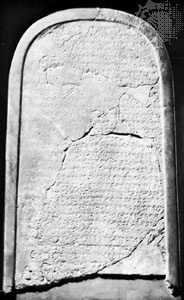Dibon
ancient city, Jordan
modern Dhībān
 ancient capital of Moab, located north of the Arnon River in west-central Jordan. Excavations conducted there since 1950 by the archaeologists affiliated with the American School of Oriental Research in Jerusalem have uncovered the remains of several city walls, a square tower, and numerous buildings. The pottery found on the site dates from Early Bronze (c. 3200–c. 2300 BC) to Early Arabic (c. 7th century AD), although pottery dating from the Middle and Late Bronze ages (c. 2300–c. 1550 BC; c. 1550–c. 1200 BC) is very rare, thus adding weight to the modern assumption that a great part of Transjordan reverted to nomadism during that time.
ancient capital of Moab, located north of the Arnon River in west-central Jordan. Excavations conducted there since 1950 by the archaeologists affiliated with the American School of Oriental Research in Jerusalem have uncovered the remains of several city walls, a square tower, and numerous buildings. The pottery found on the site dates from Early Bronze (c. 3200–c. 2300 BC) to Early Arabic (c. 7th century AD), although pottery dating from the Middle and Late Bronze ages (c. 2300–c. 1550 BC; c. 1550–c. 1200 BC) is very rare, thus adding weight to the modern assumption that a great part of Transjordan reverted to nomadism during that time.One of the most important finds at Dibon was the discovery in 1868 of the so-called Moabite Stone, bearing an inscription of Mesha, king of Moab, about the 9th century BC; its 34-line inscription commemorates a victory over the Israelites that reestablished the independence of Moab.